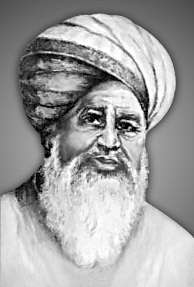Haji Shariatullah
| Haji Shariatullah | |
|---|---|
 | |
| Born |
1781 Madaripur, Dacca, Mughal India (now in Dhaka, Bangladesh) |
| Died |
1840 Dacca, British India (now in Bangladesh) |
| Nationality | Bengali |
| Known for | Faraizi Movement |
| Children | Muhsinuddin Ahmad |
| Islam in Bangladesh |
|---|
 |
| History |
| Architecture |
| Major figures |
| Culture and literature |
| Communities |
| Religious jurisprudence |
| Ideology/schools of thought |
| Mosques |
|
| Politics |
| Educational organizations and institutions |
| Influential bodies |
Haji Shariatullah (1781–1840) was an eminent Islamic reformer of the Indian subcontinent in British India. He is known for founding the Faraizi movement. Shariatpur District is named after him.[1]
Early life
Shariatullah was born in 1781 into a petty Talukdar family at the Shamail, Madaripur sub-district, Faridpur District in Bengal. His father, Abdul Jalil Talukdar, was a farmer who was not very well off. He died when Shariatullah was 8 years old. After his primary education he went to Calcutta and was admitted to Barasat Alia Madrasa. He then received education from a madrasa in Furfura Sharif, Murshidabad.[2]
In 1799, Shariatullah travelled to Arabia. He stayed there until 1818 and got his religious education. He learnt Arabic and Persian from his teacher, Maulana Basharat. During his stay in Arabia, he was influenced by the Najdi da'wah started by Muhammad bin Abdul Wahhab,[1] through Tahir al-Sumbal Makki.[3] He is said to have visited Al Azhar.[3]
Faraizi movement
Shariatullah founded the Faraizi movement which was a religious reform movement in the 19th century for Bengali Muslims. The term Faraizi was taken from fard which means standing for compulsory and mandatory duties ordained by Allah. Shariatullah instructed his followers to assimilate every religious duty required by the Quran as well as by the Sunnah, while remaining firmly in the Hanafi school of Islamic jurisprudence.[4] He called for observance on the five fundamentals of Islam, insisted on the complete acceptance and strict observance of monotheism and prohibited all digressions from the original doctrines of Islam as shirk (polytheism) and bid`at (sinful conception).[1] Haji Shariatullah deemed British domination in Bengal as detrimental to the religious life of Muslims.
Reception
The Faraizi movement thus began to circulate with astonishing speed in the districts of Dhaka, Faridpur, Madaripur, Barisal, Mymensingh and Comilla. Some Muslims, on the other hand, particularly the landlords of Dhaka, hence, reacted sharply against him and this caused a riot in Noyabari, Dhaka District.[1] Due to the reaction of these landlords and Hindu landlords and European indigo planters, this movement swelled into a socio-economic issue.[5]
Gradually incidents caused by the Faraizi movement could be witnessed in various parts of Bengal. The outraged landlords built up a propaganda campaign with the British officials, incriminating the Faraizis with mutinous mood. In 1837, these Hindu landlords accused Shariatullah of attempting to build up a monarchy of his own, similar in lines to Titu Mir. They also brought several lawsuits against the Faraizis, in which they benefitted dynamic cooperation of the European indigo planters. Shariatullah was placed under the detention of the police in more than one instance, for purportedly inciting agrarian turbulences in Faridpur.[1]
Death and legacy
After the death of Haji Shariatullah in 1820, leadership of the Faraizi movement passed to his only son, Muhsinuddin Ahmad popularly known as Dudu Miyan.[6]
Palong thana of Madaripur, a district in the Dhaka Division of Bangladesh was named Shariatpur District in honor of Haji Shariatullah.[2] Bangladesh issued a postage stamp commemorating him on 10 March 1993.[7] The 450 metres (1,480 ft) Hazi Shariatullah Bridge over the Arial Khan River on the Mawa-Bhanga highway is named after him.[8]
References
- 1 2 3 4 5 Khan, Muin-ud-Din Ahmad (2012). "Shariatullah, Haji". In Islam, Sirajul; Jamal, Ahmed A. Banglapedia: National Encyclopedia of Bangladesh (Second ed.). Asiatic Society of Bangladesh.
- 1 2 "Haji Shariatullah". Muslim Ummah of North America. Muslim Ummah of North America. Retrieved 22 February 2015.
- 1 2 Banu, Razia Akter (1992). Islam in Bangladesh. BRILL. pp. 35–37. ISBN 9004094970. Retrieved 13 March 2015.
- ↑ Hua, Shiping. Islam and Democratization in Asia. Aligarh: Cambria Press. p. 160. ISBN 978-1621969006.
- ↑ Uddin, Sufia M. (2006). Constructing Bangladesh: Religion, Ethnicity, and Language in an Islamic Nation. University of North Carolina Press. pp. 53–54.
- ↑ Khan, Muin-ud-Din Ahmed (2012). "Faraizi Movement". In Islam, Sirajul; Jamal, Ahmed A. Banglapedia: National Encyclopedia of Bangladesh (Second ed.). Asiatic Society of Bangladesh.
On the death of Haji Shariatullah in 1840 his only son Muhsinuddin Ahmad alias Dudu Miyan was acclaimed the head of the Faraizi movement.
- ↑ "Haji Shariat Ullah". Bangladesh Post Office. Retrieved 31 May 2015.
- ↑ "Hazi Shariatullah Bridge was inaugurated". Roads and Highways Department. Retrieved 31 May 2015.